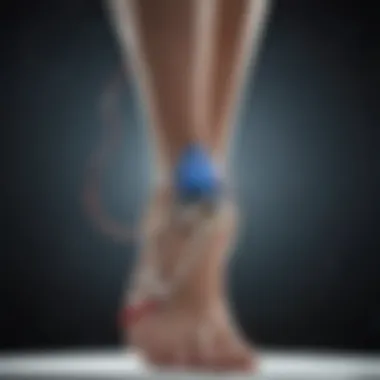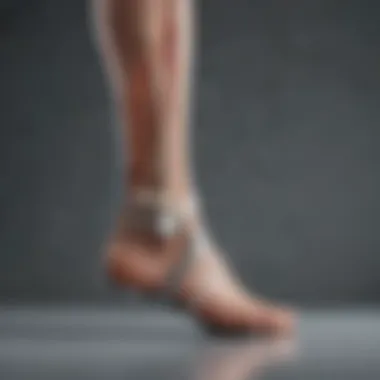Heel Cord Surgery in Cerebral Palsy: An In-Depth Exploration


Intro
Heel cord surgery is a critical intervention for individuals with cerebral palsy. It addresses the complications that can hinder mobility and quality of life. Cerebral palsy often impacts muscle control and coordination, leading to abnormal gait patterns. These patterns frequently result from tightness in the heel cord, or Achilles tendon, limiting proper movement.
This article provides a deep dive into heel cord surgery, exploring various methodologies, preoperative assessments, and postoperative care. Understanding these aspects is essential for professionals, educators, and students in medical and rehabilitation fields. The goal is to elucidate the role of this surgery in managing the complex needs of those affected by cerebral palsy.
Key Findings
Summary of the main results
Heel cord surgery has been shown to produce significant improvements in mobility for children and adults with cerebral palsy. Studies indicate that patients often experience enhanced gait, reduced pain, and improved stability following the procedure. Outcomes vary depending on the individual's specific condition, age, and level of preoperative function.
Significance of findings within the scientific community
The implications of these findings highlight the importance of tailored approaches to treatment. Researchers emphasize that results can differ considerably among patients, underscoring the necessity of personalized surgical plans. This attention to individual variability is crucial for advancing the understanding of effective interventions in cerebral palsy treatment.
Implications of the Research
Applications of findings in real-world scenarios
As more data emerges regarding heel cord surgery, healthcare practitioners are better equipped to make informed decisions. Effective surgical techniques can lead to substantial improvements in patients' ability to participate in daily activities. This enhances not only their physical capabilities but also their overall quality of life.
Potential impact on future research directions
The ongoing exploration of techniques and outcomes in heel cord surgery fosters further inquiries into cerebral palsy management. Future research may focus on optimizing preoperative assessments and postoperative rehabilitation strategies. Such efforts could pave the way for refining surgical methods and improving long-term outcomes for patients.
"Surgical intervention, when appropriately indicated, can transform the mobility landscape for individuals with cerebral palsy."
Understanding these critical elements provides valuable insight for students, researchers, and healthcare professionals involved in treating this complex condition. By evaluating surgical efficacy, the medical community can continue to refine approaches that enhance the lives of those with lower limb mobility issues.
Prelude to Cerebral Palsy
Cerebral palsy is one of the most common conditions affecting children today, warranting extensive examination. Understanding this disorder is crucial for multiple stakeholders, including medical professionals, caregivers, and educators. The nuances of cerebral palsy involve not only the medical aspects but also the social and emotional contexts that shape the lives of those affected.
Definition and Prevalence
Cerebral palsy is defined as a group of permanent movement disorders. These disorders appear in early childhood and affect muscle coordination and body movement. The cause often stems from brain damage during pregnancy, childbirth, or shortly after birth. According to the Centers for Disease Control and Prevention, approximately 1 in 345 children are diagnosed with cerebral palsy, making its recognition vital for public health awareness.
Types of Cerebral Palsy
Cerebral palsy is categorized primarily into spastic, dyskinetic, ataxic, and mixed types. Spastic cerebral palsy, characterized by tight and stiff muscles, is the most common type. Dyskinetic cerebral palsy leads to involuntary movements, while ataxic cerebral palsy affects balance and coordination. Understanding these categories is important as it guides treatment decisions, including the potential need for surgeries like heel cord surgery.
Impact on Mobility
The impact of cerebral palsy on mobility may vary significantly among individuals. Many experience limitations in movement, which can greatly hinder daily activities. Some may rely on assistive devices for walking, while others might require surgical interventions for better mobility. The relationship between cerebral palsy and mobility issues highlights the importance of early diagnosis and tailored treatment plans to enhance the quality of life for those affected.
Understanding Heel Cord Deformities
Heel cord deformities are a significant concern in children and adults with cerebral palsy. They can have a profound effect on mobility and overall quality of life. Understanding these deformities allows clinicians to evaluate the need for surgical intervention more effectively.
Characteristics of Heel Cord Tightness
Heel cord tightness is primarily defined by a reduced range of motion in the ankle joint. When this occurs, the Achilles tendon does not function properly. This tightness can manifest as a consistent equinus deformity, where the heel does not touch the ground when standing. The consequences of this condition can be severe, leading to misalignment of the feet and, ultimately, inefficient gait patterns.
Symptoms of heel cord tightness may include:
- Limited upward bending of the foot.
- Difficulty walking or running.
- Pain in the calf region.
- Increased risk of falls due to instability.
Mechanically, tightness of the heel cord may hinder the ankle's ability to reposition effectively. This can result in compensatory movements that adversely affect other joints in the lower extremity. Therefore, a thorough understanding of the characteristics of heel cord tightness is necessary for the successful implementation of treatment strategies.
Causes and Mechanisms
The causes of heel cord deformities in cerebral palsy can be multifaceted. Primarily, they stem from imbalances in muscle strength and spasticity. In children with cerebral palsy, muscle tone can be hypertonic, leading to unequal pull on the joints and tendons. Over time, this may result in structural changes in the heel cord and associated tissues.


Key contributors to heel cord deformities include:
- Spasticity: It often leads to muscle overactivity and tightness.
- Lengthening of the Gastrocnemius: This may become insufficient, resulting in biomechanical imbalances.
- Altered Motor Control: The inability to execute normal movement patterns often exacerbates deformities.
These mechanisms affect both the functionality and adaptability of the individual’s musculoskeletal system. Understanding these causes is critical, as it underlines the necessity for timely intervention, whether surgical or non-surgical, to address the long-term implications of heel cord deformities in individuals with cerebral palsy.
Rationale for Surgical Intervention
The rationale for surgical intervention in heel cord deformities among individuals with cerebral palsy is essential to understand the clinical outcomes and overall patient well-being. The decision to proceed with surgery often arises from a complex blend of medical, functional, and social factors that affect the patient's mobility and quality of life. This section explores the key elements justifying surgical intervention, including clinical indications, patient selection, and the expected benefits post-surgery.
Indications for Heel Cord Surgery
Surgical intervention for heel cord tightness is typically indicated when conservative treatment options have not resulted in significant improvement. Several specific conditions may necessitate surgery:
- Severe Plantar Flexion Contracture: When the calf muscles and tendons become excessively tight, leading to difficulty in walking.
- Functional Limitations: Patients who demonstrate marked limitations in mobility that impede daily functions may benefit from surgical correction.
- Pain and Discomfort: Individuals experiencing pain due to heel cord tightness may find relief through surgery.
- Inability to Achieve Optimal Foot Positioning: Patients who cannot attain an adequate foot position for gait or standing need surgical solutions to improve their mechanics.
These indications reflect a range of clinical scenarios, and careful assessment by a multidisciplinary team is crucial. Factors such as age, family support, and comorbidities also play a vital role in decision-making.
Goals of Surgery
The primary goals of heel cord surgery revolve around improving overall functionality and enhancing the patient’s quality of life. Key objectives include:
- Restoration of Normal Gait Mechanics: Surgical procedures aim to correct the underlying biomechanical issues to ensure a more efficient walking pattern.
- Reduction of Pain: Many procedures focus on relieving discomfort and pain associated with tight heel cords.
- Improvement of Mobility: The desired outcome is to enhance mobility, encouraging greater participation in activities, both recreational and daily.
- Facilitation of Rehabilitation: Post-surgery, successful rehabilitation can further drive improvements in functionality and independence.
Achieving these goals requires collaboration between surgeons, therapists, and care teams. One cannot overlook the significance of tailoring surgical approaches to individual patient profiles to maximize the surgical benefits.
"The rationale behind surgical choices must align with patient needs, focusing on enhancing mobility and life quality."
Preoperative Considerations
Understanding the preoperative considerations in heel cord surgery for individuals with cerebral palsy is vital. This phase lays the groundwork for a successful surgical outcome. The complexity of this condition requires a tailored approach that considers the unique needs of each patient. Identifying the specific challenges and ensuring that the patient is properly prepared can significantly influence recovery and overall results.
Comprehensive Assessment
A comprehensive assessment before surgery is fundamental. It encompasses a thorough medical evaluation and functional assessment, involving both clinical and possibly radiological examinations. Specialists must evaluate overall physical health, including skeletal alignment and muscle strength.
Additionally, joint range of motion and spasticity levels must be assessed. This understanding helps to develop an individualized surgical plan. Patient history is also crucial. Knowledge of previous surgeries or interventions can inform current decisions and strategies. Even minor details can greatly impact preoperative planning and subsequent surgical care.
Patient Education
Patient education prior to surgery cannot be overstated. It serves to demystify the surgical process and set realistic expectations. Patients, along with their families, should have a clear understanding of the procedure itself, including what to anticipate before, during, and after surgery.
Information on pain management post-surgery is also necessary. Educating about rehabilitation protocols will enable patients to engage actively in their recovery. Ensuring that patients and guardians know the risks, benefits, and goals of the surgery promotes informed consent and alleviates anxiety surrounding the procedure.
Ultimately, a well-informed patient is better positioned for a successful surgical experience, bridging the gap between clinical practice and patient involvement.
Surgical Techniques
Surgical techniques play a pivotal role in addressing heel cord deformities in individuals with cerebral palsy. These methods are not only crucial for correcting physical impairments but also essential for enhancing mobility and overall quality of life. Different techniques have been developed over the years to cater to the varying degrees of muscle tightness and related issues faced by patients. This section discusses the specific procedures and their implications, aiming to provide clarity on their uses and advantages.
Tenotomy Procedures
Tenotomy is a surgical technique that involves cutting a tendon to release its tension. In the context of heel cord surgery, it specifically addresses tightness in the Achilles tendon, which can severely restrict movement.
Benefits of Tenotomy:
- Immediate Relief: This procedure often results in instant reduction of muscle tightness, facilitating better range of motion.
- Simplicity: It is relatively less invasive compared to other surgical options, leading to quicker recovery times.
- Precision: Surgeons can tailor the procedure based on individual assessments, making it a personalized approach.
However, potential risks should also be considered. There is a possibility of complications like infection and improper healing. Proper patient selection and thorough preoperative assessment can mitigate these risks.
Lengthening Techniques
Lengthening techniques are designed to elongate tendons or muscles that are too short. This can be particularly effective for individuals with cerebral palsy, whose Achilles tendons may exhibit significant tightness.
Types of Lengthening Procedures:


- Z-Lengthening: This involves making a zigzag incision along the tendon, allowing for better extension without excessive tension.
- Bilateral Lengthening: In some cases, both legs may require simultaneous surgical intervention to maintain balance in mobility.
Considerations:
- Recovery Time: Lengthening procedures typically require longer rehabilitation periods compared to tenotomies.
- Functional Outcomes: Success can vary based on the preexisting conditions of the patient and the degree of tightness.
Innovative Approaches
Innovation in surgical techniques continues to evolve, providing new avenues for treatment. Current advancements focus on minimizing invasiveness and improving long-term outcomes.
Examples of Innovative Techniques:
- Endoscopic Surgery: Utilizing small incisions and a camera allows for a less invasive approach with reduced recovery time.
- Botulinum Toxin Injections: This method temporarily weakens the targeted muscles, providing an opportunity for better surgical outcomes when combined with traditional techniques.
"Advancements in surgical techniques for heel cord surgery represent a promising future for better treatment of cerebral palsy complications."
Future Directions:
- Personalized Medicine: Increasing focus on individual-specific surgical plans to maximize effectiveness.
- Integration of Technology: Continued adoption of robotic assistance in surgeries could result in improved precision and outcomes.
Postoperative Management
Postoperative management is crucial in the context of heel cord surgery for those with cerebral palsy. It includes the care provided immediately after surgery and extends into the rehabilitation phase. Effective postoperative management can significantly influence recovery outcomes, including functional mobility improvements and overall patient quality of life.
This stage involves careful monitoring to prevent complications and to promote healing. Many factors come into play, which include the patient's age, general health, and specific surgical procedure performed. A well-structured management plan ensures that patients receive a comprehensive approach to recovery, addressing both physical and emotional aspects of healing.
Acute Care Following Surgery
Post-surgical acute care is the first step in the recovery process. It involves a systematic approach to monitor vital signs, pain management, and the evaluation of the surgical site. Patients might experience discomfort, swelling, and restricted mobility in the immediate aftermath of the procedure. Thus, effective pain management is essential.
Common components of acute care include:
- Pain assessment and management: Utilization of medications, such as acetaminophen or stronger opioids if necessary, to ensure patient comfort.
- Wound care: Regular checks for signs of infection or complications, including redness or discharge. Keeping the surgical site clean is paramount.
- Physical support: Assistance for patients in positioning and mobility to avoid strain on the healing tissues. Crutches or walkers might be needed.
- Fluid intake and nutrition: Maintaining hydration and nutritional support to facilitate the healing process.
Overall, timely and adequate acute care can help set the stage for a smoother transition to rehabilitation.
Rehabilitation Protocols
Rehabilitation protocols are essential following heel cord surgery to restore function and improve mobility. These protocols vary based on the individual's condition but generally include exercises designed to strengthen the lower limbs and improve range of motion. A physiotherapist usually oversees this phase.
Key aspects of rehabilitation include:
- Physical therapy exercises: Initially, these may focus on gentle range-of-motion activities, gradually increasing to more intense strength training as the patient progresses.
- Functional activities: Engagement in activities that mimic daily tasks can help integrate skills into everyday life. This might involve walking on different surfaces or climbing stairs.
- Education on body mechanics: Teaching patients the correct ways to move and use their muscles ensures safety and prevents future injuries.
- Regular assessments: Keeping close monitoring of the patient's progress allows for adjustments in therapy and a more tailored rehabilitation process.
Outcomes of Heel Cord Surgery
Assessing the outcomes of heel cord surgery in cerebral palsy is crucial for understanding its impact on patients. This section highlights the significant improvements in functional mobility and quality of life that can be achieved through this surgical intervention. It also considers various factors that contribute to the overall success of such procedures. The insights gathered can help patients, families, and healthcare providers make informed decisions about treatment options.
Functional Mobility Improvements
Functional mobility is a key focus when evaluating the outcomes of heel cord surgery. Many patients with cerebral palsy experience tightness in their heel cords, contributing to gait abnormalities. Surgical intervention aims to alleviate these tightness issues, allowing for improved mobility.
Studies show that patients who undergo heel cord surgery often demonstrate clearer gait patterns post-operation. Increased ankle flexibility is commonly noted, which can enhance walking and standing capabilities. Patients may report reduced energy expenditure when ambulating, making daily movements less strenuous.
"Surgery can provide a bridge to increased independence, significantly affecting how patients interact with their environment."
In addition to enhanced mobility, there are secondary benefits such as:
- Improved balance and coordination: As patients regain strength in their lower limbs, they often experience better stability.
- Reduction in fall risk: With improved mobility and balance, the likelihood of falls decreases, which is a common concern for individuals with cerebral palsy.
- Facilitated participation in activities: Children and adults alike may find themselves engaging in physical activities more confidently, leading to a more active lifestyle.
Patient Quality of Life
The quality of life for patients undergoing heel cord surgery can see marked improvement following the procedure. Surgery not only enhances physical capabilities but also contributes to psychological well-being.
Patients often report increased satisfaction with daily activities and social interactions after surgery. This can result from several factors:


- Greater independence: Enhanced functional mobility allows patients to perform daily tasks with reduced assistance, fostering self-reliance.
- Improved self-esteem: Successfully navigating their environment can bolster confidence. Patients often feel a sense of achievement in overcoming previous limitations.
- Enhanced social inclusion: With improved mobility, individuals can participate more fully in social settings, which positively affects mental health.
As healthcare providers evaluate patient outcomes, it is crucial to consider both functional and emotional enhancements post-surgery. Monitoring long-term effects helps to refine surgical techniques and postoperative rehabilitation practices.
In summary, the outcomes of heel cord surgery can provide profound benefits. Understanding these aspects supports conversations among stakeholders, ultimately aiming for the best patient-centric solutions.
Potential Complications
Understanding the potential complications associated with heel cord surgery in patients with cerebral palsy is essential for informed medical decisions. Surgery can offer significant benefits, but it also carries risks. Patients and caregivers must be aware of these risks to make the best choices regarding treatment plans.
Surgical Risks
Surgical risks encompass various potential issues that might arise directly from the surgical procedure. These include:
- Infection: Surgical sites are susceptible to infection, which can lead to delayed healing and complications.
- Anesthesia Complications: General anesthesia poses certain risks. Forms of reaction may vary from mild to severe.
- Bleeding: Uncontrolled bleeding can occur during or after surgery, necessitating transfusions and affecting recovery time.
- Nerve Damage: Surgical manipulation can inadvertently harm nearby nerves, leading to loss of sensation or mobility issues.
- Failure of Surgical Technique: In some cases, the primary objective of the surgery may not be achieved, requiring further interventions.
It is crucial for surgeons to conduct a thorough preoperative assessment to mitigate these risks as much as possible. Proper surgical techniques and adherence to protocols can help minimize potential issues during surgery.
Long-Term Complications
Long-term complications can arise from both the surgical procedure itself and the inherent challenges of managing cerebral palsy. Complications can include:
- Changes in Gait: Postoperative alignment may alter the patient’s gait, leading to instability or other mobility concerns.
- Recurrence of Tightness: The heel cords may develop tightness again over time, requiring additional treatments or surgeries.
- Joint Issues: Complications can lead to increased strain on adjacent joints, potentially causing arthritis or other orthopedic issues.
- Psychosocial Effects: Long-term physical changes might impact emotional well-being or self-image, sometimes leading to anxiety or depression.
"Awareness of both immediate and long-term complications is vital for promoting optimal recovery and understanding the overall impact of heel cord surgery on individuals with cerebral palsy."
The importance of monitoring after surgery cannot be overstated. Regular follow-ups enable healthcare providers to identify and address complications early on, ensuring that patients receive the most comprehensive care possible.
Quality of Evidence and Research Gaps
In the realm of heel cord surgery for patients with cerebral palsy, it is crucial to understand the quality of evidence supporting existing practices. High-quality evidence not only informs clinical decision-making but also helps in delivering optimal patient outcomes. Currently, the body of literature is somewhat fragmented, with numerous studies presenting varying outcomes and methodologies.
Current Research Findings
Recent studies have highlighted significant advances in surgical techniques and postoperative care. Evidence indicates that procedures like tenotomy and lengthening can indeed improve functional mobility in many patients. However, the research has also shown inconsistencies in long-term results.
- A study published in the Journal of Pediatric Orthopaedics found that, while short-term mobility improves, not all patients experience sustained benefits.
- Another research conducted at a leading rehabilitation center emphasizes the importance of a tailored rehabilitation protocol following surgery for effective recovery.
These findings illustrate a need for a cohesive framework to evaluate and compare outcomes more effectively. By harnessing data from various studies, there may emerge clearer guidelines that could enhance the predictability of surgical success.
Identifying Research Needs
To advance the understanding of heel cord surgery in cerebral palsy, it is essential to identify specific research gaps. Some areas warrant more investigation:
- Longitudinal Studies: There is a dearth of studies observing patients over long periods post-surgery. Such data could highlight long-term efficacy and potential complications that are not apparent in short-term assessments.
- Comparative Effectiveness Research: Insights into different surgical techniques and their outcomes could better inform clinical choices. This could involve head-to-head comparisons of tenotomy versus lengthening, for instance.
- Multidisciplinary Approaches: Engaging various professionals in research could lead to a more holistic understanding of patient needs. Collaboration with physiotherapists, occupational therapists, and psychologists can enrich the research.
By focusing on these areas, the research community can enhance the understanding of heel cord surgery outcomes, ultimately striving for improved quality of life in children and adults with cerebral palsy.
"Innovative research methods can contribute significantly to understanding the efficacy of surgical interventions, paving the way for improved practices and methodologies."
It is paramount that studies continue to evolve, integrating advancements in surgical tech with comprehensive assessments of long-term patient outcomes.
Closure
In this article, we have examined the complex landscape of heel cord surgery within the framework of cerebral palsy. The significance of understanding this topic cannot be overstated. As earlier sections detailed, heel cord deformities play a crucial role in the mobility challenges faced by individuals with cerebral palsy. By addressing these deformities through surgical interventions, we can greatly enhance the quality of life for many patients.
Summary of Key Insights
Heel cord surgery is more than just a procedure; it is a lifeline for improved mobility. Below, key insights summarize the essential information provided throughout this exploration:
- Surgical Necessity: Heel cord tightness is a common occurrence in patients with cerebral palsy, often leading to significant mobility impediments.
- Preoperative Evaluation: Thorough assessment of a patient’s condition plays a vital role in determining the appropriateness of surgery. This includes the evaluation of mobility, strength, and overall health.
- Surgical Options: There are several surgical techniques available. Recognizing which method suits each patient's unique circumstances is critical.
- Postoperative Care: Effective rehabilitation strategies are paramount to ensuring patients regain strength and function post-surgery.
- Ongoing Research: Continuous studies are needed to better understand the long-term effects of heel cord surgeries and improve surgical techniques.
Future Directions in Research
Looking ahead, there are several important areas for future research on heel cord surgery and its impact on patients with cerebral palsy:
- Longitudinal Studies: More studies tracking long-term outcomes of patients who have undergone heel cord surgery can provide important data on the efficacy and potential complications over time.
- Technique Innovations: Investigating innovative surgical techniques may reveal more effective approaches with fewer complications.
- Patient-Specific Approaches: Researching personalized surgical plans based on individual patient anatomy can enhance recovery outcomes.
- Quality of Life Measures: Future studies should focus on how surgical interventions affect overall patient quality of life beyond just mobility improvements.
"Research must keep evolving to meet the demands of diverse patient needs."
In sum, as our grasp of heel cord surgery in the context of cerebral palsy matures, it will be essential to prioritize ongoing research, surgical advancements, and carefully tailored approaches for each patient.







